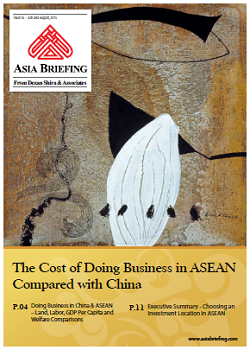 The newest issue of Asia Briefing magazine, titled “The Cost of Doing Business in ASEAN Compared with China“, is out now and available as a complimentary download in the Asia Briefing Bookstore.
The newest issue of Asia Briefing magazine, titled “The Cost of Doing Business in ASEAN Compared with China“, is out now and available as a complimentary download in the Asia Briefing Bookstore.
Contents:
- Doing Business in China & ASEAN – Land, Labor, GDP Per Capita and Welfare Comparisons
- Executive Summary – Choosing an Investment Location in ASEAN
As China continues along its development path, costs are rising in the country. This fact has both negative and positive consequences for foreign companies: while it will add to the production costs of locally-based manufacturers, it is also indicative of an increasingly affluent Chinese consumer class. Our research indicates that, if manufacturing capacity elsewhere in Asia can reach 70 percent of Chinese capabilities, lower ASEAN operating costs means it is a viable proposition to relocate. This is a generalization of course, and variants will affect individual business models, but this holds true as a general rule of thumb.
It is worth pointing out that, when broaching this subject with a Chinese production manager, there will inevitably be resistance against uprooting or even relocating part of any Chinese production facility. This means that the economic cost data analysis to determine just how competitive your China operation is needs to be conducted by non-Chinese managers.
In this issue of Asia Briefing magazine, we provide a comprehensive overview of the cost of doing business in China compared with the Association of Southeast Asian Nations (ASEAN). We analyze some of the key considerations that will impact upon the profits of an Asia-based business, including labor costs, social welfare, and industrial land prices. In addition, we take a look at how ASEAN’s export volume and GDP per capita currently compares with China.
Recent EU and U.S. surveys have both concluded that it is becoming harder to maintain profitability levels in China. For certain businesses, now is the right time to be evaluating options.
|
Asia Briefing Ltd. is a subsidiary of Dezan Shira & Associates. Dezan Shira is a specialist foreign direct investment practice, providing corporate establishment, business advisory, tax advisory and compliance, accounting, payroll, due diligence and financial review services to multinationals investing in China, Hong Kong, India, Vietnam, Singapore and the rest of ASEAN. For further information, please email asia@dezshira.com or visit www.dezshira.com. Stay up to date with the latest business and investment trends in Asia by subscribing to our complimentary update service featuring news, commentary and regulatory insight.
|
![]()
The 2015 Asia Tax Comparator
In this issue, we compare and contrast the most relevant tax laws applicable for businesses with a presence in Asia. We analyze the different tax rates of 13 jurisdictions in the region, including India, China, Hong Kong, and the 10 member states of ASEAN. We also take a look at some of the most important compliance issues that businesses should be aware of, and conclude by discussing important tax and finance concerns.
Manufacturing Hubs Across Emerging Asia
In this issue of Asia Briefing Magazine, we explore several of the region’s most competitive and promising manufacturing locales including India, Indonesia, Malaysia, Singapore, Thailand and Vietnam. Exploring a wide variety of factors such as key industries, investment regulations, and labor, shipping, and operational costs, we delineate the cost competitiveness and ease of investment in each.
 ASEAN’s Investment Horizons: Key Industries for AEC 2015
ASEAN’s Investment Horizons: Key Industries for AEC 2015
In this issue of Asia Briefing, we forecast the effects of ASEAN Economic Community on foreign investment into the region in the lead up to 2015. Following this, we highlight what is happening in some of ASEAN’s hottest industries for investment, including electronics, information and communications technology, textiles and medical devices. Lastly, we examine the growing potential of bilateral trade between ASEAN and India.



